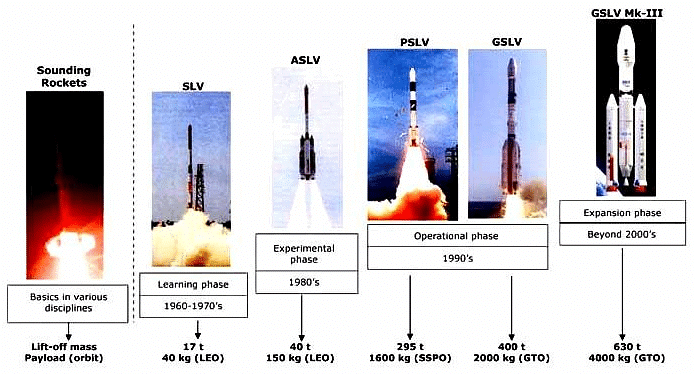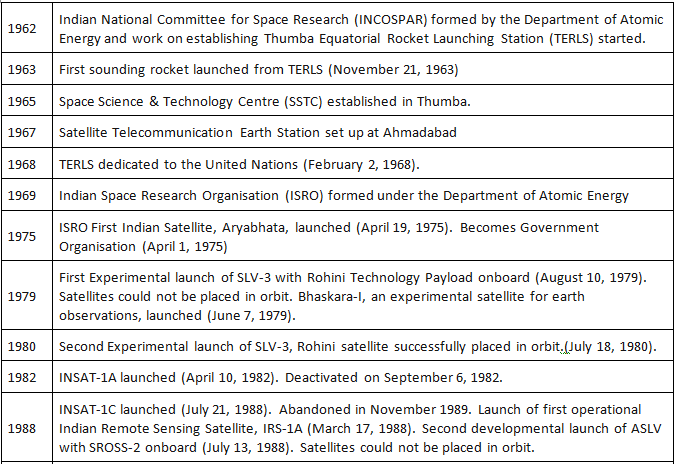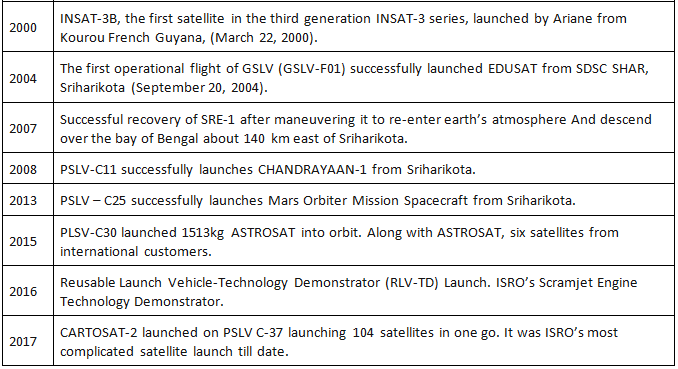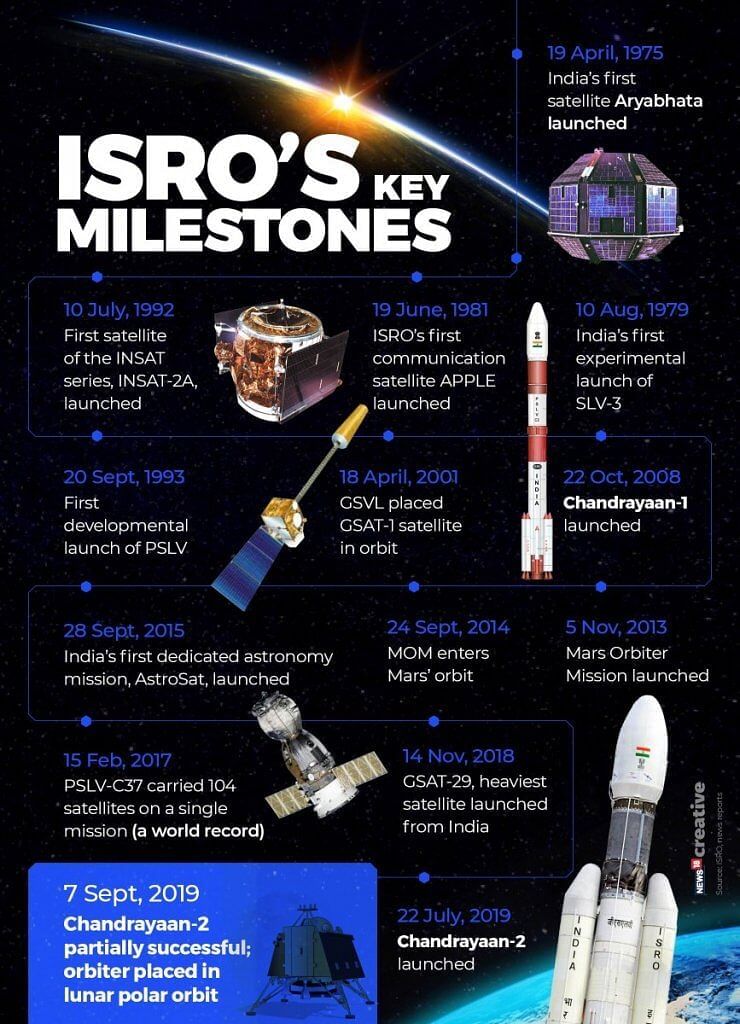UPSC Exam > UPSC Notes > Geography Optional for UPSC > Indian Space Programme
Indian Space Programme | Geography Optional for UPSC PDF Download
Introduction
- Indian Space Program is guided by a possibilistic approach.
- Indian Space Program is the tool for regional development.
- Indian Space Program is based on the network of optical fibre and wireless communication-based systems.
Objectives of Indian Space Program
- Indian Space Research Organization (ISRO) is the nodal agency and flag bearer in the Indian Space Program.
- ISRO performs a wide array of services apart from their main mission of building and launching space missions and their launch vehicles for a wide variety of objectives.
- ISRO has also contributed to science and science education in the country.
- Various dedicated research centres and autonomous institutions for remote sensing, astronomy and astrophysics, atmospheric sciences and space sciences in general functions under the aegis of The Department of Space.
- Thus from above the objectives of the Indian Space Program is twofold:
- Space discovery and exploration through space missions
- Promotion of research and education related to space science in the country. E.g. Tele-education in remote areas in India.
- Some of the other functions of Indian Space Program are:
- Resource management such as mineral resources, agriculture, marine resources etc.
- Environment conservation
- Internal security and terrorism. E.g. use of IRNSS for regional security
- Weather forecasting
- Disaster Management
Communications satellites India
Indian National Satellite (INSAT) Series
- The Indian National Satellite (INSAT) system is one of the largest domestic communication satellite systems in the Asia-Pacific region with nine operational communication satellites placed in Geo-stationary orbit.
- INSAT System consists of 14 operational satellites, namely – INSAT-3A, 3C, 4A, 4B, 4CR, 3DR and GSAT-6, 7, 8, 10, 12, 14, 15 and 16.
- Application of INSAT satellite includes:
- Educational TV Services
- Telemedicine Programme
- Television
- Satellite Aided Search and Rescue
- Disaster management
- Helps in Geopolitics like SAARC satellite.
- Helps in the commercialization of space programs, like launching the communication satellites of Russia USA, etc.
Indian Remote Sensing Satellite (IRS)
- Starting with IRS-1A in 1988, ISRO has launched many operational remote sensing satellites. Today, India has one of the largest constellations of remote sensing satellites in operation.
- IRS satellite consists of CARTOSAT, OCEANSAT & RISAT (Resource Sat) Satellites
- Application of IRS satellites:
- Disaster Management Support
- Bio Resources and Environment survey and mapping e.g. RESOURCESAT
- Cartography e.g. CARTOSAT
- Agriculture & Soil
- Rural and Urban Development e.g. National Drinking Water mission
Important Milestones in Indian Space Program
1. Phase I: 1960-70 (Incipient Stage)
- Dr. Vikram Sarabhai was the founding father of the Indian space program and is considered not only a scientific visionary.
- After the launch of Sputnik in 1957, he recognized the potential that satellites provided. India’s first Prime Minister, Pt. Jawaharlal Nehru, who saw scientific development as an essential part of India’s future, placed space research under the jurisdiction of the Department of Atomic Evergy in 1961.
- The DAE Director Homi Bhabha, who is regarded as the father of India’s atomic program, then established the Indian National Committee for Space Research (INCOSPAR) with Dr. Sarabhai as Chairman in 1962.
- From its establishment in 1962, the Indian space program began establishing itself with the launch of sounding rockets, which was complemented by India’s geographical proximity to the equator.
- Thumba Equatorial Rocket Launching Station (TERLS) was built near Thiruvananthapuram in south Kerala.
- India developed an indigenous technology of sounding rockets called Rohini Family of sounding rockets.
- In 1969, the India Space Research Organisation (ISRO) was created and finally, the Department of Space was established in 1972.
2. Phase II: 1970-80
- Sarabhai had taken part in an early study with NASA regarding the feasibility of using satellites for applications as wide as direct television broadcasting.
- India began the development of satellite technology, anticipating the remote sensing and communication needs of the future.
- India’s first foray into space began with the launch of its satellite Aryabhata in 1975 by a Soviet booster.
- By 1979, the SLV was ready to be launched from a newly established second launch site, the Sriharikota Rocket Launching Station (SRLS).
- The first launch in 1979 was a failure, attributed to control failure in the second stage. By 1980, this problem had been worked out.
- The first indigenous satellite launched by India was called Rohini.
3. Phase III: 1980-90
- Following the success of the SLV, ISRO was keen to begin construction of a satellite launch vehicle that would be able to put the truly useful satellite into polar orbit
- The Augmented Satellite Launch Vehicle (ASLV) was tested in 1987, but this launch was a failure. After minor corrections, another launch was attempted in 1988, and this launch again failed.
4. Phase IV: 1990-2000
- It was not until 1992 that the first successful launch of the ASLV took place.
- The first successful launch took place in 1994, and since then, the PSLV has become the workhorse launch vehicle, placing both remote sensing and communications satellites into orbit, creating the largest cluster in the world, and providing unique data to Indian industry and agriculture.
Developments after 2000
- In 2001, the first development flight of the GSLV took place.
- India is developing a project to send an unmanned probes to the moon in 2008, as the first attempt at an exploration of the solar system. This project is called Chandrayaan.
- ISRO has entered the lucrative market of launching payloads of other nations upon its rockets from Indian soil.
- After 2010, ISRO has embarked on the following programmes:
- Launch Vehicle development programme comprising of Polar Satellite Launch Vehicle (PSLV), Geosynchronous Satellite Launch Vehicle (GSLV), and next generation GSLV Mark-III launch vehicle missions.
- Earth Observation programme consisting of state-of-the-art Indian remote sensing (IRS) satellites viz. Resourcesat, Cartosat, Oceansat, Radar Imaging Satellite, Geo-Imaging Satellite and weather/climate satellites viz. INSAT-3DR missions.
- Satellite Navigation programme consisting of constellation of 7 Indian Regional Navigation Satellite System (IRNSS) along with associated ground segment intended to provide accurate positional information and timing services.

Dateline of Indian Space Program



The document Indian Space Programme | Geography Optional for UPSC is a part of the UPSC Course Geography Optional for UPSC.
All you need of UPSC at this link: UPSC
|
303 videos|636 docs|252 tests
|
FAQs on Indian Space Programme - Geography Optional for UPSC
| 1. What is the Indian Space Programme? |  |
The Indian Space Programme refers to the initiatives and activities undertaken by the Indian government and its space agency, the Indian Space Research Organisation (ISRO), to explore and utilize space technology for various applications. It includes the development of space vehicles, satellite launches, and the establishment of satellite-based communication, navigation, and remote sensing systems.
| 2. What are the objectives of the Indian Space Programme? |  |
The objectives of the Indian Space Programme are multifaceted. They include:
- Advancing scientific research: The programme aims to conduct scientific experiments and research in areas such as astronomy, astrophysics, planetary exploration, and space physics.
- Communication and broadcasting: The programme aims to provide satellite-based communication and broadcasting services, including telephony, television, and internet connectivity, especially in remote and rural areas.
- Remote sensing and mapping: The programme focuses on developing and utilizing remote sensing satellites for mapping, monitoring natural resources, disaster management, urban planning, and agricultural applications.
- Navigation and positioning: The programme aims to establish an indigenous navigation system, similar to GPS, for accurate positioning, navigation, and timing services across the country.
- Human spaceflight: The programme aspires to send astronauts into space, fostering human spaceflight capabilities and conducting experiments in microgravity.
| 3. What are some notable achievements of the Indian Space Programme? |  |
The Indian Space Programme has achieved several notable milestones, including:
- Mars Orbiter Mission (MOM): In 2014, India became the first country to successfully reach Mars on its first attempt, with the MOM spacecraft. It showcased India's cost-effective approach to interplanetary missions.
- Chandrayaan-1: India's first lunar mission, launched in 2008, discovered evidence of water molecules on the Moon's surface, enhancing our understanding of lunar geology.
- Geosynchronous Satellite Launch Vehicle (GSLV): The GSLV has been instrumental in placing communication satellites in geostationary orbits. It signifies India's self-reliance in launching heavier satellites.
- Indian Regional Navigation Satellite System (IRNSS): The IRNSS, also known as NavIC, is India's indigenous navigation system, providing accurate positioning and timing services over the Indian subcontinent.
| 4. How does the Indian Space Programme benefit the country? |  |
The Indian Space Programme brings numerous benefits to the country, including:
- Communication and connectivity: Satellite-based communication services provided by the programme bridge the digital divide by ensuring connectivity in remote and rural areas, enabling telephony, internet access, and broadcasting services.
- Disaster management: The programme's remote sensing satellites aid in disaster management by providing timely information on natural disasters, helping in preparedness, response, and recovery efforts.
- Resource mapping and monitoring: Satellite-based remote sensing helps in mapping and monitoring natural resources, facilitating better land use planning, water resource management, agriculture, and forestry.
- National security: The programme's space assets play a crucial role in enhancing national security through surveillance, reconnaissance, and intelligence gathering.
- Technological advancements: The programme fosters technological advancements, promoting research and development in space technology, which often finds applications in other sectors, leading to innovation and economic growth.
| 5. How does the Indian Space Programme contribute to international cooperation? |  |
The Indian Space Programme actively engages in international cooperation through partnerships, collaborations, and knowledge sharing. Some notable contributions include:
- Launch services: ISRO provides affordable launch services to other countries, enabling them to place their satellites into space. It has launched satellites for various countries, including the United States, United Kingdom, and France.
- Data sharing: ISRO offers its remote sensing data to other countries, facilitating global initiatives in disaster management, climate change studies, and environmental monitoring.
- Training and capacity building: ISRO conducts training programs and workshops for scientists and engineers from other countries, sharing its expertise and helping in capacity building efforts.
- Joint missions and research: India collaborates with other space agencies on joint missions and research projects, such as the NASA-ISRO Synthetic Aperture Radar (NISAR) mission, promoting scientific cooperation and knowledge exchange.
Related Searches
















